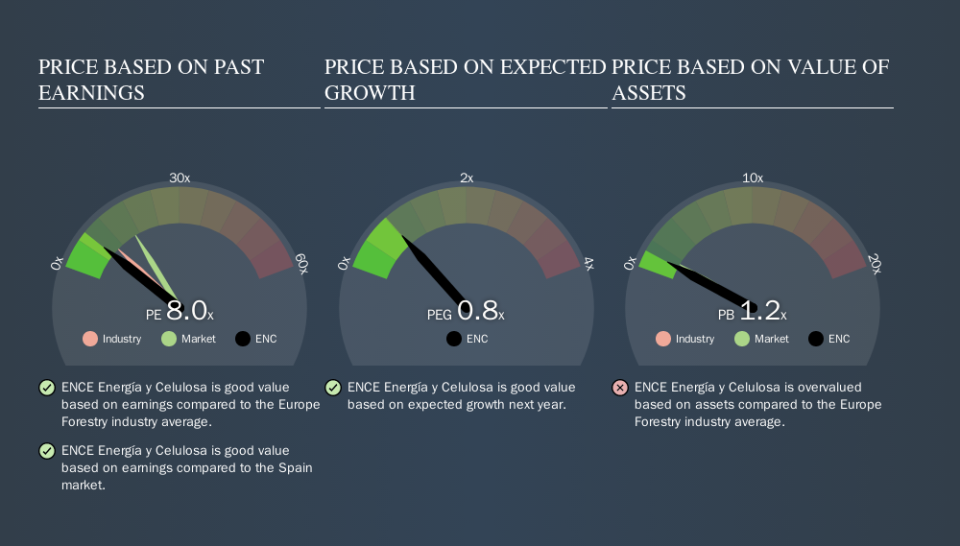Do You Know What ENCE Energía y Celulosa, S.A.'s (BME:ENC) P/E Ratio Means?

Today, we'll introduce the concept of the P/E ratio for those who are learning about investing. We'll show how you can use ENCE Energía y Celulosa, S.A.'s (BME:ENC) P/E ratio to inform your assessment of the investment opportunity. ENCE Energía y Celulosa has a price to earnings ratio of 8.03, based on the last twelve months. In other words, at today's prices, investors are paying €8.03 for every €1 in prior year profit.
View our latest analysis for ENCE Energía y Celulosa
How Do You Calculate A P/E Ratio?
The formula for price to earnings is:
Price to Earnings Ratio = Price per Share ÷ Earnings per Share (EPS)
Or for ENCE Energía y Celulosa:
P/E of 8.03 = €3.39 ÷ €0.42 (Based on the trailing twelve months to June 2019.)
Is A High P/E Ratio Good?
The higher the P/E ratio, the higher the price tag of a business, relative to its trailing earnings. That isn't necessarily good or bad, but a high P/E implies relatively high expectations of what a company can achieve in the future.
How Does ENCE Energía y Celulosa's P/E Ratio Compare To Its Peers?
One good way to get a quick read on what market participants expect of a company is to look at its P/E ratio. The image below shows that ENCE Energía y Celulosa has a lower P/E than the average (10.3) P/E for companies in the forestry industry.
ENCE Energía y Celulosa's P/E tells us that market participants think it will not fare as well as its peers in the same industry. While current expectations are low, the stock could be undervalued if the situation is better than the market assumes. It is arguably worth checking if insiders are buying shares, because that might imply they believe the stock is undervalued.
How Growth Rates Impact P/E Ratios
Generally speaking the rate of earnings growth has a profound impact on a company's P/E multiple. That's because companies that grow earnings per share quickly will rapidly increase the 'E' in the equation. That means even if the current P/E is high, it will reduce over time if the share price stays flat. A lower P/E should indicate the stock is cheap relative to others -- and that may attract buyers.
ENCE Energía y Celulosa shrunk earnings per share by 7.1% last year. But it has grown its earnings per share by 40% per year over the last three years.
Remember: P/E Ratios Don't Consider The Balance Sheet
Don't forget that the P/E ratio considers market capitalization. That means it doesn't take debt or cash into account. The exact same company would hypothetically deserve a higher P/E ratio if it had a strong balance sheet, than if it had a weak one with lots of debt, because a cashed up company can spend on growth.
Such spending might be good or bad, overall, but the key point here is that you need to look at debt to understand the P/E ratio in context.
How Does ENCE Energía y Celulosa's Debt Impact Its P/E Ratio?
ENCE Energía y Celulosa has net debt equal to 47% of its market cap. While it's worth keeping this in mind, it isn't a worry.
The Verdict On ENCE Energía y Celulosa's P/E Ratio
ENCE Energía y Celulosa's P/E is 8.0 which is below average (16.6) in the ES market. With only modest debt, it's likely the lack of EPS growth at least partially explains the pessimism implied by the P/E ratio.
Investors have an opportunity when market expectations about a stock are wrong. If the reality for a company is not as bad as the P/E ratio indicates, then the share price should increase as the market realizes this. So this free visual report on analyst forecasts could hold the key to an excellent investment decision.
Of course you might be able to find a better stock than ENCE Energía y Celulosa. So you may wish to see this free collection of other companies that have grown earnings strongly.
We aim to bring you long-term focused research analysis driven by fundamental data. Note that our analysis may not factor in the latest price-sensitive company announcements or qualitative material.
If you spot an error that warrants correction, please contact the editor at editorial-team@simplywallst.com. This article by Simply Wall St is general in nature. It does not constitute a recommendation to buy or sell any stock, and does not take account of your objectives, or your financial situation. Simply Wall St has no position in the stocks mentioned. Thank you for reading.

